The unprecedented spread of COVID-19 is causing changes in the way people live, the way they shop and the way they interact online. And those changes are happening quickly.
We want to keep you as up-to-date as possible with what’s going on - the insights we’re seeing across the world, the new trends in consumer behavior, and the lessons advertisers and marketers need to learn at lightning speed - so you can stay informed, adapt your plans, and respond to what’s happening in your market.
In this episode of Insights Track, Will Green, Senior Content strategist and Robert Jones, VP Research and Insight, discuss how COVID-19 is accelerating the rise of connected TV and are joined by guest speaker Brian Ecclesine, VP of National Sales, China, to discuss how how advertising in China is recovering.
Listen to the Insights Track podcast on Spotify or Soundcloud.
Even before the COVID-19 outbreak, viewing habits were changing. Research firm eMarketer had already projected that the number of U.S. cord cutters - those who had canceled their cable TV subscriptions - would increase to one fifth of US households by 2021, and one fourth by the end of 2022. Meanwhile more than half (51.5%) of UK households subscribe to one or more OTT services, and in Canada more than one fourth of households (26%) have cut the cord.
As the Coronavirus has spread throughout the United States, UK, and Canada, we’ve all become familiar with social distancing and seen countries enact different measures to slow the spread of the disease, forcing non-essential businesses to close and asking people to stay home. The net result is a population now stuck inside with a glut of free time and the TV as one of the key ways to fill it. .
TV doesn’t just mean TV
Before we dive into the data, it’s important to note that the advent of connected TVs has changed the way we consume media overall. In the United States, Nielsen estimates that 68% of households have a connected TV device (either a connected smart TV or a device that accomplishes this, like a game console or Amazon Fire). In Canada, more than 50% of households have a smart TV and the UK isn’t far behind with 48%.
What this means is that OTT and digital video viewing are now just as likely to happen on a TV in the living room as they are on a smartphone, computer, or tablet. Moreso, in fact - the majority of OTT viewing for apps like Netflix and even YouTube TV take place on a TV, and for some OTT apps that percentage can be as high as 80%. So when we talk about the distinction between TV and OTT here, think of it as the distinction between “linear, cable TV” and “everything else” - and remember that we aren’t just talking about computer screen viewing for OTT.
Share of ad-supported OTT inventory by platform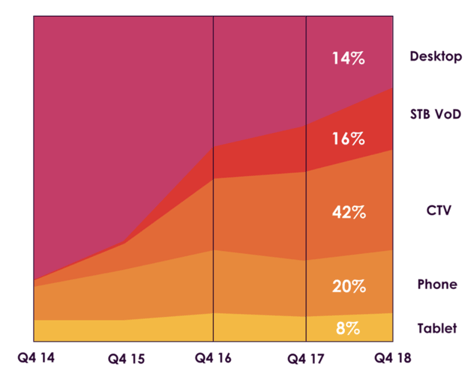
People are watching more TV than ever
During this period of lockdown, while many people are at home, they’re finding new ways to entertain themselves. And while lots of people are taking the time to finish those long-standing DIY projects, catch up on their reading, or painting landscapes (interest in DIY content online has increased substantially), there has also been a significant increase in the number of people watching TV, both linear and OTT.
Most new TV viewing happens on weekdays
Based on US data, the work-from-home schedule is driving large increases in TV viewing - both OTT and traditional - on weekdays, where viewing has increased by as much as 42% for OTT (Wednesdays). Comparatively, Saturday viewing has decreased significantly, likely because consumers are now getting their fix during the week and looking for other activities to fill their weekends.
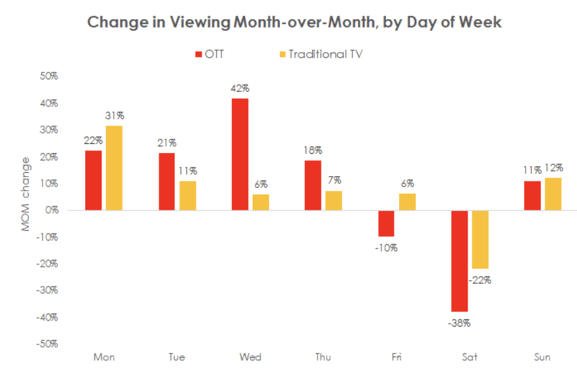
TV viewing up across every hour of the day
In terms of when people are watching more by hour of the day, the answer is “pretty much all of them.” daytime and fringe viewing are both up significantly for OTT and traditional TV viewing. This suggests that these dayparts, traditionally seen as relevant for reaching housewives and older consumers, now hold significantly larger value for advertisers trying to reach all audiences.
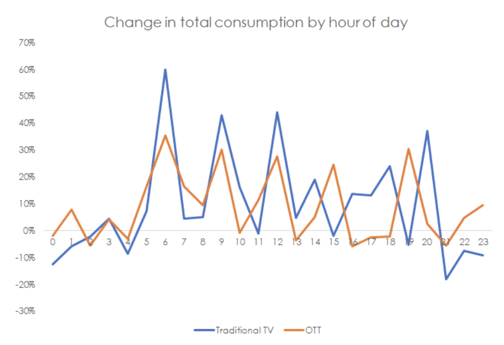
Older consumers are tuning into OTT for the first time
Another trend that the Coronavirus is likely accelerating is the shift to OTT for older consumers and cord cutting for younger consumers. For younger consumers (18-34), traditional/linear TV viewing decreased in March while OTT viewing increased. Likewise, traditional and OTT viewing are up significantly for P35+, including people ages 55 to 64, indicating that many of these consumers may be making more dedicated forays into the format.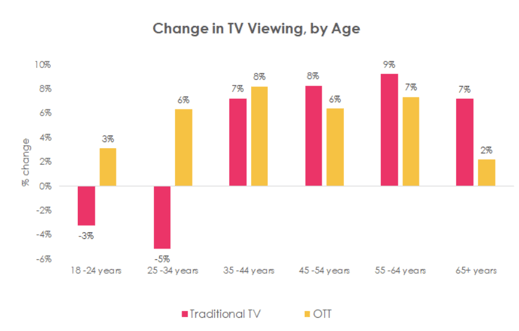
Content preferences are shifting
As we move into an extended period of social distancing with more time for content consumption, habits are shifting. Interest in news content saw the largest increase (32%) in March as consumers tuned in for updates about the virus, though interest in movies and premium content (such as HBO) also saw significant increases. Scripted content is the big winner here -- consumers are looking for escapism where they can get it.

With no sports to watch, fans are going elsewhere
In a trend we’ve seen mirrored in other countries, as the major sports leagues have suspended or cancelled their seasons, interest in sports programming has waned, and audiences have gone elsewhere. Overall viewership for sports TV programming decreased 14% in March, and interest continues to decline. For advertisers, this means several very specific, engaged audiences can no longer be reached in these environments, leaving brands to find other ways of reaching them as they seek out other content.
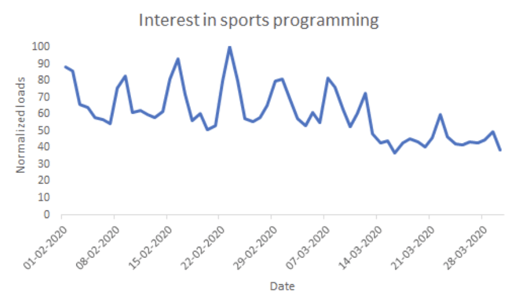
Digital video viewing also on the rise globally
Digital video viewing is also on the rise, with more available impressions being created week-over-week in the UK, US, and Canada.
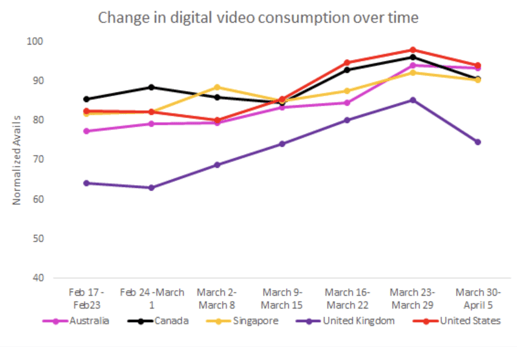
Identifying cord cutters, cord nevers, and cord trimmers
Using data from connected TVs (via MiQ’s integration with Vizio and LG in the United States and Samba in Australia), we can identify not just the content being watched on those TVs, but the apps and devices being used to watch that content. The resulting data can be used to build a dataset that shows how households are watching content. The households that only watch via apps or OTT fall into our “Cord-X” category, and generally cannot be effectively reached through traditional, linear TV.
Segmenting TV viewers by viewing environment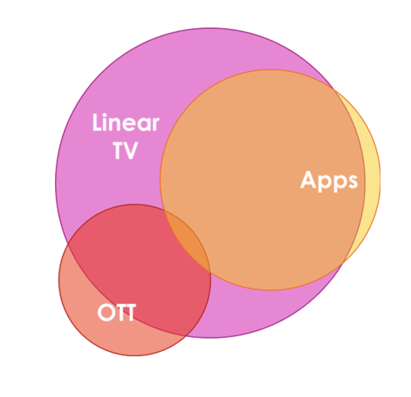
The impact for political advertisers and charity, advocacy, and cause-based campaigns
Political and advocacy advertisers have traditionally relied on TV buys to reach their target audience, with a heavy reliance on local news programming to reach an informed audience. And while news consumption is up, younger audiences and OTT-first audiences will likely be watching less news overall and getting their news from other sources. The upside is that there are significantly more opportunities to reach the same audience elsewhere, on other types of content.
Advertisers need to rethink their strategies now
This is all happening right now, and the longer advertisers wait, the more they risk waiting too long to wade into the new environment, missing a chance to be in front of consumers at a crucial moment, when inventory is readily available and demand is relatively low. Doing this correctly means having a way to connect traditional and digital channels, and to understand how consumers are watching digital content on their TVs.
If you want insights like these delivered straight to your inbox, subscribe to our insights mailing list.



